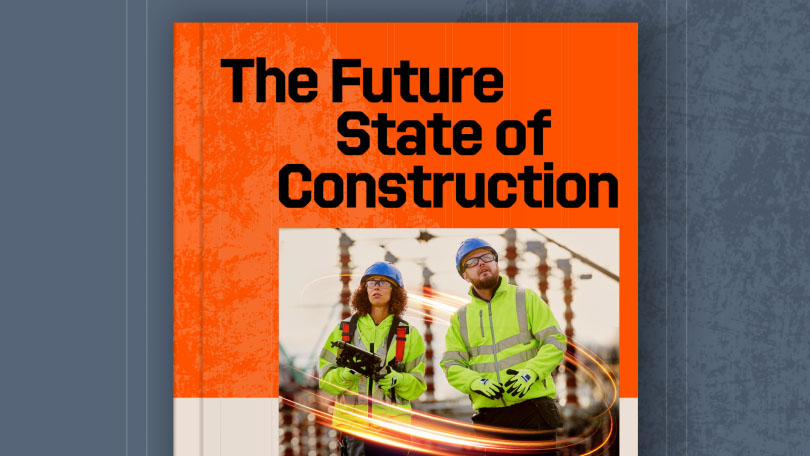— 10 min read
Construction Cost Estimating: a Step-by-Step Guide

Last Updated Aug 28, 2025

Brendan McGurk
Strategic Product Consultant - Construction Financials
20 articles
"Brendan is a Strategic Product Consultant for Procore Financials, where he enjoys leading and innovating internal company processes to deliver on both public and private projects. He brings 12 years of experience working in various construction roles ranging from builder's hand to quantity surveyor and project manager on both the owner and main contractor side.
Originally studying Accounting, he changed direction to quantity surveying after the Christchurch Earthquake in 2011. He is now qualified and an NZIQS-recognised Quantity Surveyor. He’s since worked on projects from feasibility, concept design, and value engineering right through to construction and post-construction support.

Nicholas Dunbar
Content Manager
62 articles
Nick Dunbar oversees the creation and management of UK and Ireland educational content at Procore. Previously, he worked as a sustainability writer at the Building Research Establishment and served as a sustainability consultant within the built environment sector. Nick holds degrees in industrial sustainability and environmental sciences and lives in Camden, London.
Last Updated Aug 28, 2025

Construction estimating is a crucial process in the construction industry, as it involves accurately predicting the cost of a project before work begins. Within the United Kingdom, construction estimating is typically carried out by trained estimators or Quantity Surveyors (QSs) who specialise in estimating and managing construction costs.
Construction estimating is the process of evaluating all costs associated with a specific construction project. The costs generally include direct and indirect expenses, overhead, and mark-ups.
- Direct costs: Funds allocated toward aspects or items of the construction process such as materials, labour and equipment.
- Indirect costs: Any costs that are not directly associated with construction activities. That may include utilities, quality control, administration, permits, security, legal fees, etc. This can also be known as Preliminary and General.
- Labour hours: All costs associated with the actual construction of the project - the wages or rate paid to the team, estimated hours for each task and potential overtime.
- Subcontractor expenses: Estimated expenses for duties that go out to subcontractors, including labour, materials and equipment.
It is vital that the construction estimate (made during the pre-construction phase) is conducted properly. Ideally, cost estimates are produced by a professional construction estimator who can provide accurate and valid reasons as to how much the job will cost, along with identifying any risk, based on skill and past experience; the process can be complex.
Learn more: The 6 phases of construction project management
Table of contents
The Importance of Accurate Estimating
Construction estimating is important because it helps both the owner-developer (and/or client) plus the contractors determine whether a project is feasible within the allotted budget. It also helps stakeholders determine if value engineering - the process of improving the value of a product or service while reducing costs - needs to be carried out, as doing so can reveal if additional funding is required. These steps can be taken prior to tendering or during the early-contractor-engagement phase.
If the client is satisfied with the indicative price, they can either:
- Provide the quantities, plans and supporting documentation (specifications) to main contractors, to price the required scope; or
- Allow the potential main contractors to do their own take-off and estimates, as part of the tender stage.
Preparing an accurate estimate helps leading contractors understand the true bottom line of completing a project. But it also comes with the caveat that contractors, eager to secure new business for their company, will be aggressive about their approach.
Additionally, contractors rely on accurate estimates to submit competitive, profitable tenders; if they win a project only to discover that they underestimated the budget - or did not consider the full scope of works or potential risks - then profitability suffers. Likewise, overestimating the budget may result in the tender being rejected for being higher than everyone else’s.
Lastly, when negotiating during tendering, an accurate estimate will ensure that the owner-developer and contractor profit equally from the outcome.
8 Steps in Construction Estimating
Whether a construction estimator works for a main contractor, a subcontractor or an owner-developer, they typically follow the same process.
Review the Tender Pack
The tender package contains all the documents necessary for submitting a tender: JCT or NEC owner-contractor agreements, bond forms, general conditions, supplementary conditions and construction specifications. Contractors who tender on a project are bound to complete the work set out in the tender package; therefore, the construction estimator must be familiar with every aspect of the project if they are to submit an accurate estimate.
The tender package contains drawings (technical illustrations that visually represent the specifications of a construction project). Construction estimators often subdivide drawings into categories based on their purpose: architectural, structural, mechanical, electrical and plumbing, which may then be split into packages depending on the tender engagements.
Although main contractors and subcontractors will review the same documents, subcontractors often refer only to the documents relevant to the work they perform for the project.
Below are the steps that construction estimators follow when reviewing a tender package:
- Ensure all drawings and specifications are present and current.
- Get an overview of the project.
- Evaluate package requirements.
- Identify any non-standard items.
During the estimating process, the construction estimator will continually refer back to the tender documents to ensure that their estimate covers every aspect of the project’s specifications and requirements.
After reviewing the documents, a construction estimator for a main contractor will subdivide the project into work packages for subcontractors or for themselves if they use their own labour.
By reviewing the technical specifications (also called construction specifications or “specs”), the construction estimator can clearly see the scope of work according to various divisions of the NBS or RICS work breakdown: concrete, masonry, metals, finishes, plumbing, etc.
For example, a construction estimator may create a work package that includes the materials and labour for a rough-in plumbing task and another that covers the requirements for a windows-and-installation task.
Dividing a project into work packages requires extreme diligence. Therefore, a construction estimator must ensure that they:
- Include every aspect of the project in a work package.
- Avoid assigning the same work twice to multiple work packages.
- Clearly define the scope of each work package.
Once a construction estimator divides all the work into packages, the main contractor can request tenders from subcontractors for either a portion of or all the required construction work.Conduct a Site Visit
Depending on the tender requirements, site visits may be mandatory or voluntary. However, good construction estimators should always choose the former. It gives them a better understanding of the site conditions than elevation drawings and photographs can offer. The exception is subcontractors, who may need to review only the documentation provided by the owner-developer or main contractor to understand their role.
The main purpose of a site visit is to help the construction estimator understand how site conditions may influence cost. Examples include:
- Poor drainage, difficult subsurface soil conditions and adjacent buildings
- Access difficulties, which make manoeuvring equipment and delivering materials harder
- Poorly located utilities (water, electricity), which may necessitate underground works
- Surrounding properties, restrictions on working hours or on-site storage
- Factors that influence labour constants (e.g., excessively large or small quantities; very high standards of finish)
The estimator should also be familiar with the surrounding area, including:
- Local requirements (planning-permission fees, party-wall agreements, Section 106 obligations), and regulations (parking, noise, working hours)
- Availability of subcontractors and construction-equipment hire companies
- Availability of materials within the region
- Road access and suitability for heavy equipment and delivery vehicles
A site visit, therefore, is invaluable for assessing the cost and feasibility of a construction project.Perform a Material Take-Off
Also known as a quantity take-off, a material take-off is a measurement of the materials and labour required to complete a construction project. Construction estimators review the construction documents and count every item required.
Material needs are listed by measurement type. In the UK, the New Rules of Measurement (NRM) and RICS guidance set the basis for how to measure quantities:
- Quantity or count (doors, hardware)
- Area (internal wall linings, flooring)
- Volume (bulk excavation)
- Length (handrails)
- Lump sum (permits)
On large projects, the owner-developer or engineer may create a Bill of Quantities (BoQ) to simplify the tender-levelling process. Even when contractors receive a BoQ, they still perform a take-off to verify quantities and identify discrepancies via a Request for Information (RFI).
After completing a take-off, estimators have a comprehensive list of every material required. They also use this information to determine what equipment to include in each work package.Solicit Pricing from Suppliers and Vendors
Once subcontractors have a definitive list of materials and equipment, they gather pricing information from suppliers and vendors.
When pricing materials, subcontractors should note that:
- Material waste requires ordering extra materials. Although contractors strive to minimise waste, material sizing can produce off-cuts - e.g., plasterboard sold in 2.4-m sheets but used on a 2.8-m-high wall, creating additional waste.
- Bulk pricing may dictate order sizes. A contractor needing 20 000 m³ of concrete might purchase 25 000 m³ because the larger volume attracts a lower rate.
- Quotes have limited lifespans. Ensure supplier quotations remain valid long enough for your tender return, or include an allowance for escalation.
For equipment not already owned, contractors contact equipment vendors to determine hire rates for the project duration. Contractors also consider depreciation, servicing and maintenance on equipment they own or plan to buy outright. Depending on the tender and local requirements, this information may have to be provided in their estimate.
By now, contractors should have definitive numbers, which they can include in their project costs. Construction estimators then add direct, indirect and risk allowances to give contractors an idea of the project’s true financial cost.Evaluate Labour Requirements
Estimators calculate crew mixes and productivity, then apply the loaded labour rate (wages, National Insurance, pension contributions, holiday pay, union dues).
Determine Insurance, Bonding and Compliance Costs
Alongside insurance and bonding, UK estimators price statutory compliance:
- CDM 2015 duties (Principal Designer/Principal Contractor)
- Building Regulations Part L energy standards
- ISO 19650 information-management processesCalculate Overhead and Indirect Costs
Indirect field costs (permits, site cabins, professional fees, plant hire) and corporate overheads (office rent, software licences, utilities) are spread across projects.
Account for Profit and Contingency
Most UK contractors add 5–10 % contingency and a target profit margin set by board policy. For example, a typical medium-rise residential scheme might carry a contingency of £110–£160 per m², based on BCIS 2024 medians.
From Estimate to Tender Proposal
Once the estimator determines the sales price, a tender manager creates a construction proposal, detailing everything included in the tender in clear, concise terms and outlining the tender conditions (“tags”).
Assembling the submission should be an ordered process that leverages earlier planning; rushed work invites mistakes. A competent tenderer will draw on a library of previous submissions for non-price attributes such as track record, methodology and plant resources.
If the tender evaluation is 100 % price-based, focus on price. Where quality or capability scoring applies, demonstrate why your company offers the best overall value.
Tender documents are only the start.
Tender documents form the base for the contract documents; the contracting process has only just begun. A contract must have an offer, acceptance and consideration.
Your tender submission is the offer and should include everything you want in the contract documents. You may, for example, offer a discount for alternative materials that you can source more economically.
The client will assess your submission. If your tender conditions are amended, you will receive a counter-offer. Negotiations may go back and forth until both parties are willing to sign a contract.
Because tender reviewers will try to ensure that everything in the scope of work is in the tender price, be sure to use the same language as the specifications and drawings. Even for a lump-sum contract, using a standard format makes it easier to create a schedule of values and to integrate estimating software with accounting systems.
Estimating Methods (UK)
While the eight steps describe the workflow, estimators use recognised techniques to generate numbers:
- Analogous (top-down) – start with a similar completed scheme and adjust for size, location and inflation.
- Parametric – multiply a key driver (e.g., £/m²) by BCIS indices or historic data; ideal at concept stage.
- Analytical (bottom-up) – price each trade from first principles: materials, labour hours, plant and overheads.
- Delphi forecasting – solicit independent expert inputs, anonymise responses and iterate until opinions converge.
FAQs
What are the three most common estimating techniques?
Analogous, parametric and analytical - because they suit different design stages and data availability.
Is construction estimating hard?
Estimating is challenging - yet manageable - when you follow a structured process, verify quantities and rely on dependable cost data. Modern software automates take-offs and flags errors, letting you focus on risk and pricing decisions.
Categories:
Written by

Brendan McGurk
Strategic Product Consultant - Construction Financials | Procore
20 articles
"Brendan is a Strategic Product Consultant for Procore Financials, where he enjoys leading and innovating internal company processes to deliver on both public and private projects. He brings 12 years of experience working in various construction roles ranging from builder's hand to quantity surveyor and project manager on both the owner and main contractor side.
Originally studying Accounting, he changed direction to quantity surveying after the Christchurch Earthquake in 2011. He is now qualified and an NZIQS-recognised Quantity Surveyor. He’s since worked on projects from feasibility, concept design, and value engineering right through to construction and post-construction support.
Reviewed by

Nicholas Dunbar
Content Manager | Procore
62 articles
Nick Dunbar oversees the creation and management of UK and Ireland educational content at Procore. Previously, he worked as a sustainability writer at the Building Research Establishment and served as a sustainability consultant within the built environment sector. Nick holds degrees in industrial sustainability and environmental sciences and lives in Camden, London.
View profileExplore more helpful resources

Control the Chaos: Standardising Document Workflows in Construction Projects
Document control and implementation play a central role in managing risk, meeting deadlines, and delivering projects to spec. As builds become more complex and teams increasingly disperse, the volume and...

Cost-Plus Construction Contracts in the UK
A construction cost-plus contract – sometimes called a cost-reimbursable or prime cost contract – reimburses all project costs and adds a fee to cover the contractor’s overhead and profit. UK...

Digital Construction Technology for Whole-Life Value
For decades, the construction industry has kept a narrow focus on capital cost — the one-time, upfront costs of a construction project. While in the short term this seems like...

UK Construction Progress Reports: Tools for Smarter Site Management
Construction progress reports track completed work, on site issues, costs, and safety so UK project teams can demonstrate progress, secure payments, and stay on programme. Accurate progress data is essential...
